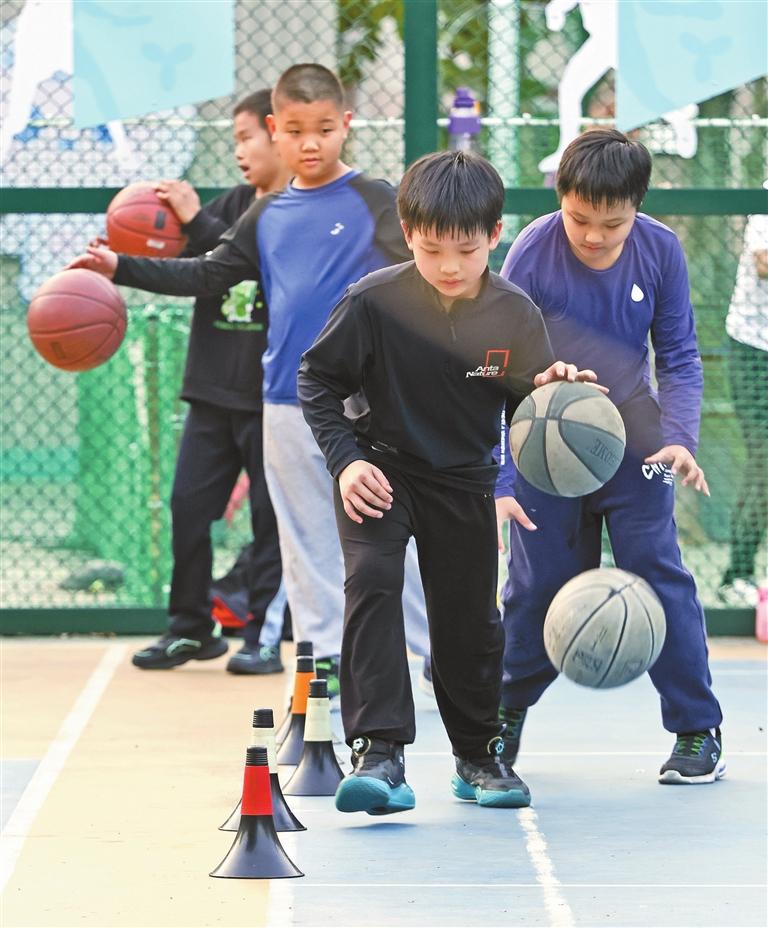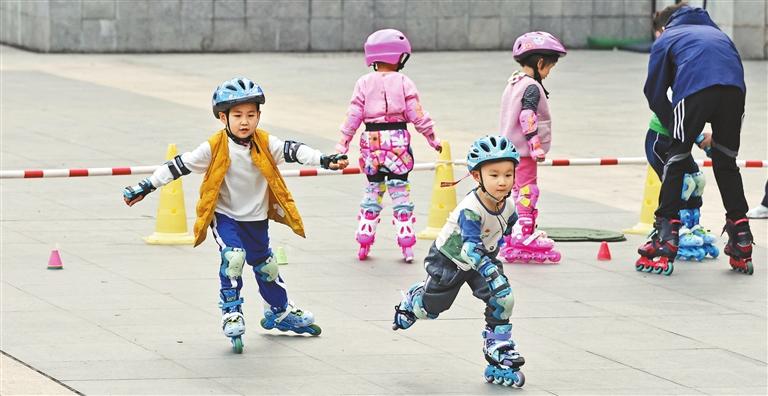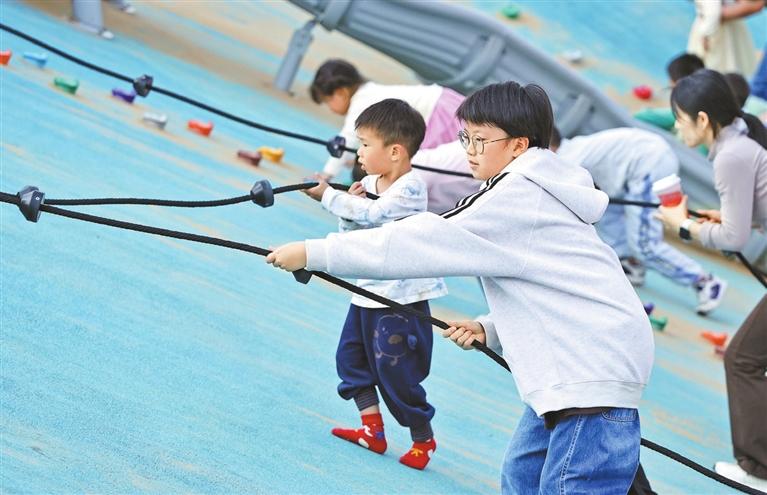


Wei Jie claudiamente@hotmail.com SHORTLY after the Spring Festival holiday, third-grader Yu Rongtao was seen doing fitness training with a private coach in the open space beside Shekou Culture and Sports Park in Nanshan District. Yu is among many schoolchildren who have been participating in off-campus fitness training under the guidance of private physical training coaches in open community spaces across Shenzhen in recent years. Fitness training tools like plastic cones, adjustable hurdle frames, jump ropes, and resistance bands are no longer confined to gym facilities and have become common in extracurricular fitness training. With the rapid growth of nationwide fitness initiatives, public awareness of the benefits of physical fitness has significantly increased. As more emphasis is placed on physical education in senior high school entrance exams, youth physical training has evolved into a proactive lifestyle. Sports performance improvement takes time and cannot be achieved through last-minute preparations for physical education exams. As a result, many parents are enrolling their children in off-campus training classes where they can train consistently under the guidance and support of professional coaches after school, on weekends, and during holidays. Worrying adolescent health figures Official data show a decline in physical health among children and adolescents in China over the past 20 years, with approximately 33% facing various degrees of health risks. A report on the prevention and control of myopia in Chinese children and teenagers, issued by the Ministry of Education in 2021, highlighted that more than 50% suffered from nearsightedness. Specifically, myopia rates were 35.6% for primary school children, 71.1% for junior high students, and 80.5% for senior high students. Myopia is associated with an increased likelihood of severe eye diseases. A 2020 report from the National Health Commission revealed that nearly 20% of children aged 6 to 17 were overweight or obese. Additionally, the “Guidelines for the Prevention and Control of Type 2 Diabetes in China (2020 Edition)” pointed to a concerning upward trend in the incidence of diabetes among children and adolescents, particularly type 2 diabetes. Even more alarming is that due to a lack of systematic health education, physical monitoring, and intervention programs, fewer than 30% of students engage in the recommended one hour of exercise each day. To address the pressing issue of youth health, the Ministry of Education issued a directive in 2021 mandating that primary and secondary school students have at least one hour of both on-campus and off-campus physical activity daily, aimed at strengthening their physical health management. The following year, the newly revised Sports Law stipulated that physical education classes cannot be occupied for other purposes, legally guaranteeing students at least one hour of physical exercise daily during school hours. Several years ago, when public awareness of fitness was not as pronounced, physical education classes in schools were often waived for academic subjects, which were considered more important. In Shenzhen, schools have been required to offer one physical education class every day during the compulsory education period since Jan. 1, 2024. Private physical training coaches Zhao Zichao, a private physical training coach, trains Yu and several other students from No. 4 Primary School of Yucai Education Group in Shekou Culture and Sports Park after school and on weekends. “Most of my students start with skipping and running, as both are good forms of physical training for young children,” said the coach. Schools often require children to meet specific skipping targets, and parents expect coaches to assist their children in practicing. “Mastering skipping requires coordination of hands and feet, as well as significant strength and stability in the feet, legs, and ankles,” said Zhao. The seasoned instructor added that coaches do not have children jump right away. Instead, they start with leg strength exercises. “It’s also important to include breaks during skipping to ensure the heart rate remains within a safe range.” Yu started to train with Zhao twice a week after school last year. “Initially, we wanted the coach to help him improve his skipping for better performance on the PE exam at school,” said Yu’s mother, a psychotherapist with The Hong Kong University Shenzhen Hospital. Over time, Yu’s training expanded beyond skipping to include exercises such as running and flexibility training. Yu’s mother noted that outdoor physical training has brought her son unexpected benefits, such as improved eyesight, because they guaranteed that the boy had ample exposure to natural sunlight, which helps regulate eye growth and prevents excessive elongation. Coach Geng Zhijie believes that running is the most efficient form of physical training available in schools. “With a comfortable pair of sports shoes, students can run anytime and anywhere. Running together makes the experience much less monotonous and more enjoyable,” he said. Zhang Minmin, a resident in Futian District, shared that her daughter, a fourth-grader at Yuanling Primary School, used to be reluctant to exercise. However, since the introduction of daily physical education classes, she has become more willing to run. “At first, she needed a little encouragement. But after running regularly for a couple of months, she found that the clothes she once complained were tight had become loose. She now believes running has helped her look slimmer,” said Zhang. Zhang’s daughter runs a daily average of 1,200 meters during school breaks and participates in the weekly “Sunshine Sports” program after school on Fridays. Additionally, she runs approximately 2,000 meters in each of her three after-school physical training sessions each week. “This structured physical activity greatly improved my child’s physical fitness and cardiovascular health,” Zhang added. It is crucial for children to experience the benefits of exercise to develop a consistent habit. However, Coach Geng cautioned, “If personal training sessions focus solely on running, they can become too monotonous, making it difficult for children to remain motivated.” Geng noted that while running fosters willpower through repetitive laps, younger children are not physically or psychologically well-suited for prolonged, long-distance running. “When helping children improve their fitness levels, we tailor our courses to suit their age group,” he said. For primary school students, physical training primarily involves comprehensive exercises. As children transition to secondary school, the pressure of exams leads to clearer demands and goals from both parents and students. At this stage, coaches usually incorporate activities like the long jump, running, and pull-ups into the training programs. “Many parents have misconceptions — they think that practicing the long jump is solely about jumping and that running just requires effort. The truth is, a solid physical foundation is essential to thrive in any sport,” Geng explained. “Take the standing long jump as an example. It requires core strength in the waist and abdomen to drive the legs and complete the jump. Additionally, the technique of swinging the arms to generate momentum is crucial.” Geng said that factors such as balance, flexibility, and explosive strength are all vital during physical training. “There’s no such thing as just ‘training the arms or legs.’ Even for pull-ups, starting with momentum to assist the arms necessitates engagement from the hip joints and core to generate power.” Physical training market With a background in physical education from Guangzhou Sport University, Geng started working as a children’s physical training coach in 2020 after graduation. It wasn’t a good time to enter the job market as most economic activities were on hold due to the pandemic. “The only positive change from the pandemic was that people began to focus more on and invest in their personal health,” said Geng. Given his major in sports education, which is crucial for achieving health, he and several college friends set up Xingxing Diandian Sports Training Club that year. “At that time, we chose a conventional approach to operate the business. We rented an office in Futian District and even included two sports fields to create a strong presence,” Geng said. However, the societal shutdown made their business unsustainable. “For a couple of months, we mostly sat in the office, with little income, while the sports fields remained deserted. All kinds of bills kept piling up. A change in direction became imperative,” Geng recalled. The turning point came unexpectedly when they uploaded exercise videos online. They soon received inquiries about their qualifications as professional sports coaches and whether they would train children. Geng and his team immediately shifted their focus to video promotion. “A lot of people can make videos, so we strive to ensure that each of ours addresses a specific challenge in physical training,” said Geng. For example, one video highlighted how to exercise to grow taller, addressing a common concern among parents regarding their children’s height. The strategy proved successful and resulted in a steady influx of students at the training club. Geng and his team customized specific training models based on the age of the children and their training content. “The one-on-one model lets our coaches closely observe children’s movements and strength while making gradual adjustments. With too many children in a session, it becomes difficult to focus effectively on each child, leading to less effective workouts. However, this model can be monotonous for younger children,” said Geng. To maintain engagement, the coaches also arrange small-group classes for older students and those who have already mastered basic movements. Both Geng and Zhao are optimistic about the future of this profession, as Shenzhen still faces a significant shortage of physical training coaches. According to data released April 2024 on the Shenzhen Municipal Education Bureau website, there were 2.748 million primary and secondary students in the city in 2023. The future looks bright for both children and fitness trainers like Geng and Zhao as more parents take proactive steps to improve their children's physical fitness. | 
